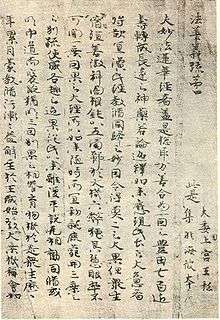Sangyō Gisho
The Sangyōsho (三経義疏 "Annotated Commentaries on the Three Sutras"), is the title of three annotated commentaries on important Buddhist sutras: Hokke Gisho (法華義疏), Shōmangyō Gisho (勝鬘経義疏), and Yuimagyō Gisho (維摩経義疏).
Hokke Gisho

An annotated commentary on the Lotus Sutra; four volumes in length. It is based on the annotated text Fahuayiji (法華義記) by Liang dynasty monk Fayun (法雲, 467-529). Approximately 70% of the contents are identical.
According to tradition, the Hokke Gisho was composed in 615 and is the oldest Japanese text. Records indicate that the manuscript was discovered by Gyōshin (行信), the monk who erected the Hōryū-ji Tō-in, and the manuscript was kept at this temple for centuries until 1878, when it was presented to Emperor Meiji as a gift.
Shōmangyō Gisho
An annotated commentary on the Śrīmālādevī Siṃhanāda Sūtra; one volume in length. It is based on annotated texts of the Liang dynasty monk Min (旻, 467-527). Traditionally said to have been completed in 611.
Yuimagyō Gisho
An annotated commentary on the Vimalakirti Sutra; three volumes in length.[1] It is based on annotated texts of the Liang dynasty priest Zhizang (458-522). Traditionally said to have been completed in 613.
Authorship
Although traditionally attributed to the semi-mythological Prince Shōtoku, current scholarly consensus disputes this and the actual authorship of the texts are unknown. The Hokke Gisho contains a note stating, "This book belongs to the private collection of King Jōgū [Prince Shōtoku] and is not from overseas." However, the brush style is different from the main text and is believed to have been later added by the priest Gyōshin.[2]
The Nihon Shoki records that in 606, Prince Shōtoku taught the Śrīmālādevī Siṃhanāda Sūtra and the Lotus Sutra, hence the belief that he authored all three.
On the seventh month of autumn, the empress summoned Hitsugi no Miko and commanded him to teach the Srimala Sutra. He finished in three days. This year, Hitsugi no Miko next taught the Lotus Sutra at Okamoto Palace. The empress was most pleased and presented Hitsugi no Miko with Tamomo Tokoro in Harima Province.[3]
Only the Hokke Gisho remains in original manuscript form, while the Shōmangyō Gisho and Yuimagyō Gisho exist only from later copies.
The oldest text to attribute the Sangyōsho to Shōtoku Taishi is the 747 Hōryūji Garan Engi Narabini Ruki Shizaichō (法隆寺伽藍縁起并流記資財帳). In addition, sutra records found in the Shōsōin documents credit King Kamitsumiya, one of Shōtoku Taishi's titles, for the annotated Lotus and Srimala sutras.
While historical records attribute these works to Shōtoku Taishi, a number of issues and problems have been pointed out.[4]
- The oldest records are all more than a hundred years after the death of Shōtoku Taishi, so they are unreliable.
- Inoue Mitsusada of the University of Tōkyō says that many texts originally attributed to rulers were actually written by groups of scholars and suggests that this is the case here as well. However, Hokke Gisho uses a number of personal pronouns weakening this argument.
- Calligrapher Nishikawa Yasushi studied the glyph forms used in the original with those in China and concludes that Hokke Gisho is a work corresponding to the Sui dynasty (581-618). Inoue builds on this suggesting that it is a work of Japan's Asuka period.
The precise development of these texts is strongly argued in modern scholarship with many alternative hypotheses. These include:
- Based on Chinese texts brought to Japan that Prince Shōtoku used as a basis for composition.
- Korean priests visiting Japan wrote it under Prince Shōtoku's instructions.
- Produced in China or Korea and authorship was transferred to Prince Shōtoku when it arrived in Japan.
- A later work
There is no academic consensus on the true authorship. If authorship is assigned to Prince Shōtoku, then the works would need to have been completed before 622 when he died.
Notes
References
- Hubbard, Jamie, trans. (2012). Expository Commentary on the Vimalakīrti Sutra. Numata Center for Buddhist Translation and Research, Berkeley, ISBN 978-1-886439-44-3. (Yuimagyō-gisho)
- Ienaga, Saburō; Fujieda, Akira; Hayashima, Kyōshō; Tsukishima, Hiroshi (1975). Nihon Shisō Taikei 2: Shōtoku Taishi Shū (in Japanese). Iwanami Shoten.
- Kubota, Jun (2007). Iwanami Nihon Koten Bungaku Jiten (in Japanese). Iwanami Shoten. ISBN 978-4-00-080310-6.
- Nakamura, Hajime; Hayashima, Kyōshō (2007). Shōmankyō Gisho, Yuimakyō Gisho (shō) (in Japanese). Chūōron Shinsha. ISBN 978-4-12-160095-0.
- Nihon Koten Bungaku Daijiten: Kan'yakuban. Tokyo: Iwanami Shoten. 1986. ISBN 4-00-080067-1.
- Sakamoto, Tarō; Ienaga, Saburō; Inoue, Mitsusada; Ōno, Susumu (1965). Nihon Koten Bungaku Taikei: Nihon Shoki (vol. 2). Iwanami Shoten. ISBN 4-00-060068-0.
- Takitō, Sonkyō; Tamura, Kōyū; Hayashima, Kyōshō (2007). Hokke Gisho (shō), Jūshichijō Kenpō (in Japanese). Chūōron Shinsha. ISBN 978-4-12-160096-7.